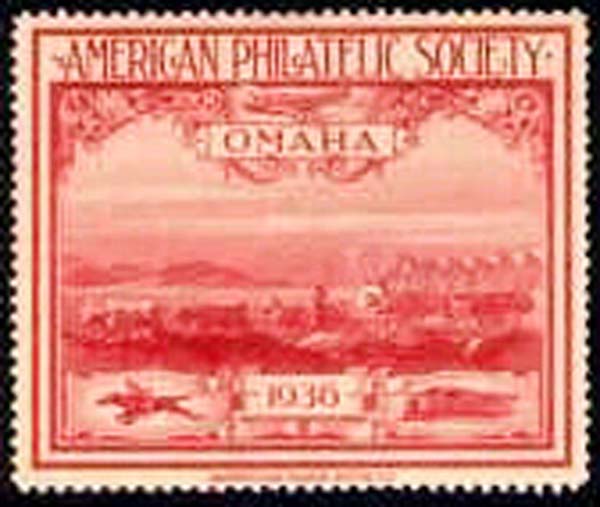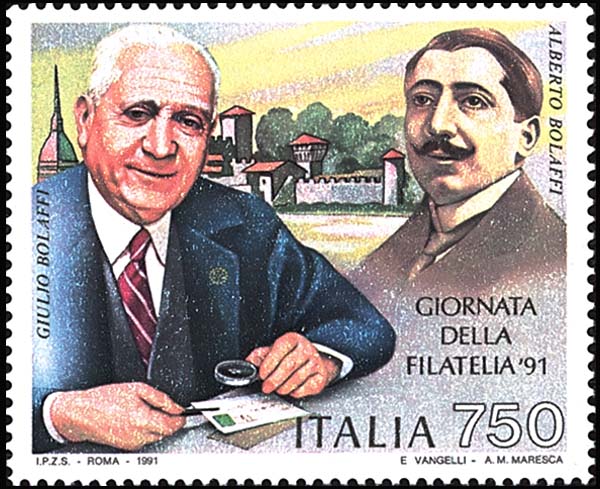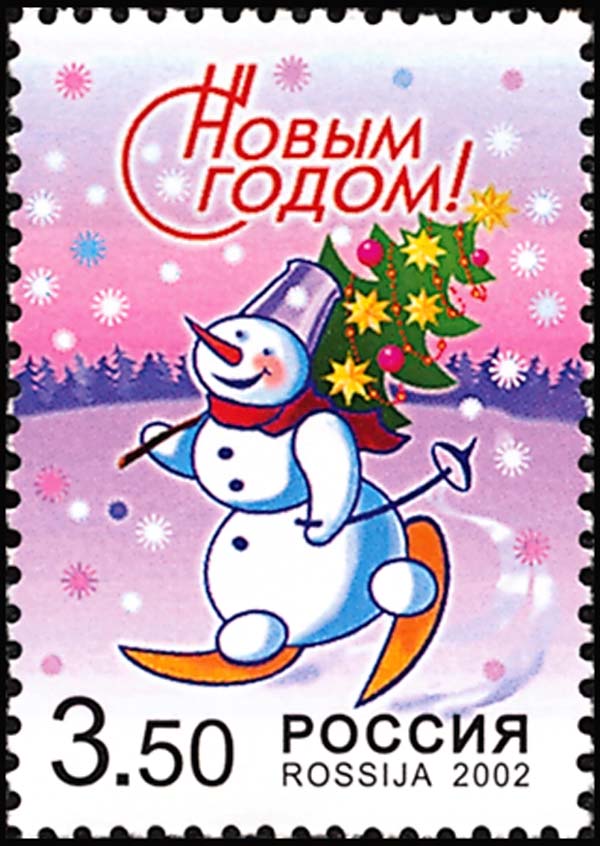POSTAL UPDATES
insights
New Year's resolutions can help your collecting
By Janet Klug
In the Northern Hemisphere, the solar New Year is celebrated shortly after the winter solstice, in late December.
The solstice marks the shortest day of the year and looks forward to the return of spring and longer, brighter, warmer days.
The ancient Romans set the beginning of the solar year after the winter solstice and named the first month of the year after Janus, the two-faced god, who looks both backward and forward in time.
In the officially atheist Soviet Union, where celebration of Christmas was strictly forbidden, much of the festivity of the season was transferred to the celebration of New Year's Day.
This including the issuance of New Year's stamps as opposed to the Christmas stamps issued in much of the rest of the western world.
Today this tradition of issuing New Year stamps continues in the post-communist successor states Russia, Ukraine and Belarus. A Russian 3.50-ruble Happy New Year stamp of 2003, Scott 6733, is shown in Figure 1.
Most cultures see the new year as a time filled with hope and promise.
If you are a stamp collector who sees the beginning of a new year as an opportunity to make a few adjustments in your life, habits or outlook, then throw in a few fun hobby-related resolutions among your general resolutions. I guarantee you will enjoy your collection more.
There are all sorts of resolutions you could make, and if you are like me, there are even more you should make, especially if they involve cleaning, filing or tidying your stamp room.
But I promised fun, not an involved clean up. So here are a few suggestions designed to enhance your stamp collecting experience. Pick just one or try them all.
Resolution No. 1. Join a local stamp club or a specialty society or both.
A local stamp club is a wonderful place to meet and interact with other stamp collectors who live in or near your hometown.
Every club is different, but most clubs operate on the same general principals. You can expect a brief business meeting followed by a program of some sort.
The programs can be quite varied. Perhaps there will be a guest speaker, a slide program, a show and tell, an auction, a pile of kiloware to root through (stamps on paper) or other stamp activity.
You will meet interesting folks with whom you already share common interests. There will undoubtedly be collectors who are beginners and collectors who are very advanced specialists, with many members fitting somewhere in between.
Sometimes stamp collectors themselves appear on postage stamps, and I don't mean the wave of personalized postage stamps becoming available from some postal administrations.
A 750-lire Giulio and Alberto Bolaffi stamp, Italy Scott 1857, is shown in Figure 2. The Bolaffis were collectors and dealers.
Coming in cold to a room full of strangers can be pretty intimidating, but remember that if you introduce yourself and mingle, you'll be a stranger only once.
Membership in a specialty society is worthwhile, even if the only reason you can think of is that it will bring an information-laden journal to you on a regular basis.
The greatest asset to forming a great collection is knowledge, and the best way to gather that knowledge is by joining a specialty society.
You can interact with other collectors and share their knowledge.
By regularly reading the society's journal, you will become conversant with new information affecting your area of interest.
You will learn how to spot desirable varieties and set aside those album weeds (forgeries) from your basic collection.
You might become so interested in fakes and forgeries that you start a new collection just for them.
Some specialty societies offer other services, including stamp exchanges, sales, auctions, new issues and identification services.
If you collect 19th-century U.S. stamps or covers, for example, you and your collection would benefit from membership in the U.S. Philatelic Classics Society. Write to Rob Lund, Membership Chairman, 2913 Fulton St., Everett, WA 98201-3733 or download an application from the web site at www.uspcs.org.
Another option for collectors of U.S. stamps is the United States Stamp Society. Write to Executive Secretary, Box 6634, Katy, TX 77491-6634 or down load an application from the web site at www.usstamps.org.
Regardless of what you collect, if you are not now a member of the American Philatelic Society, you should be.
The benefits are many: a monthly color stamp magazine; sales circuits where you can buy or sell material; expertizing; and access to the wonderful American Philatelic Research Library and its tens of thousands of books, catalogs, and journals.
For membership, write to the APS, Box 8000, State College, PA 16803 or visit the web site at www.stamps.org.
Resolution No. 2. Expand your horizons by collecting something different.
Specializing in one country or area of interest focuses your time, effort and financial resources so that completing the collection is an achievable goal.
It sounds great in theory. In practice, it seldom works that way. Consider this analogy from long-distance running: sooner or later a specialized collector will hit the wall.
You may encounter what seem to be insurmountable roadblocks. Some of the stamps you need to round out your specialized collection might not fit your budget. Some that you can afford might simply be unavailable. Suddenly your stamp collection is no longer fun.
This problem can be quickly overcome by pursuing a new interest. Maybe you can't afford to add the high-value Columbians to your U.S. collection, but you can start a topical collection of the travels of Christopher Columbus, one of his ships, or the concept of Manifest Destiny.
A 2-centavo light blue Santa Maria, Nina and Pinta stamp, Argentina Scott 90, is shown in Figure 3. With Scott catalog values of $3 used and $6 unused, hinged, it could be a relatively inexpensive start to a Columbus topical collection.
Perhaps you have completed a Germany collection as far as your pocketbook will allow. You can have a lot more fun by broadening that interest to include military and civil censored German mail, occupation stamps, or flown or unusual mail to and from Germany.
Figure 4 shows a Paraguayan 2-centavo letter card, Higgins and Gage No. A3, sent to Germany and uprated with two pairs of 1c gray Cirilo A. Rivarola stamps, Paraguay Scott 33.
The letter card is made especially interesting by the "Colonia Nueva Germania" straightline cancel, showing that it was mailed from a German settlement in Paraguay.
The world of stamps is nearly limitless, except for the limits you choose to impose. Open your mind and your album to something new, and start having fun again.
Resolution No. 3. Go to a stamp show.
Most large cities have an annual stamp bourse or show. Many have quarterly or even monthly bourses where collectors can peruse dealers' stocks and meet other collectors. Many of these shows and bourses are listed each week in Linn's Stamp Events Calendar.
Larger club shows will have exhibits assembled by other collectors who hope to inform, entertain and maybe even win a gold medal. There may be seminars and meetings you can attend. If you have never been to a stamp show, or if you haven't been to one in a long time, make this the year you venture out.
The largest show held in the country on an annual basis is the American Philatelic Society's Stampshow. In 2004 it will be held in Sacramento, Calif., Aug. 11-15.
At Stampshow you can expect to have the choice to shop with more than 100 dealers, view more than 800 frames of exhibits or attend educational seminars and first-day-of-issue ceremonies for new stamps.
You might even want to start setting money aside to attend the international show that will be held in Washington, D.C., May 27-June 3, 2006. This world's fair of philately is sure to be an event no stamp collector should miss.
You can also collect stamp exhibition labels, a type of cinderella stamp issued to promote various stamp shows. In the 1920s and 1930s many larger shows commissioned beautifully designed and printed exhibition labels. Many of them were printed by the same companies that produced the world's postage stamps at that time.
A red American Philatelic Society label for a show held in Omaha, Neb., in 1936 is shown in Figure 5.
Resolution No. 4. Read a book that relates to something you collect.
I collect stamps from most of the islands in the South Pacific, and I recently read the book Blue Latitudes. It was about the reflections and insights of a man who recreated the travels of Captain Cook.
Many of the places, people and historic events mentioned in the book are illustrated on stamps I have in my collection. The book made my stamp collection come alive, and the stamps made the book seem familiar.
As a result, I have a better appreciation of the trials and tribulations of Captain Cook's voyages, of the difficulties facing indigenous cultures in the Pacific and of my stamps that illustrate all of these ideas.
A 1½-penny blue and black Capt. James Cook stamp issued by Rarotonga, Cook Islands, Scott 63, is shown in Figure 6.
What a great hobby we have that can bring all of this together.
Resolution No. 5. My last suggestion might sound a bit like the filing and tidying I said I wasn't going to mention, but it is tidying with a difference. Honest.
Pick one box, album or accumulation and put it in order. That could mean mounting loose stamps into the album, or cataloging an envelope full of stamps that all need their perforations measured and their watermarks checked. Or, as in my case, it could mean reorganizing several cover albums that had become a disheveled mishmash of miscellaneous material.
After having done this, I can actually find what I am looking for. Frankly I was surprised to find some hidden gems that had gotten lost in the morass.
By picking just one project to reorganize, you aren't dooming yourself to failure. You can reorganize one part of your collection, can't you? And guess what? You will be surprised at how much fun it can be and how relaxing it is.
You might also be amazed to discover material that you forgot you had.
So go ahead. Make a stamp resolution. Let this be the year you make new friends, learn more about your hobby and add some terrific stamps and covers to your collection. You deserve it.
Happy New Year!
MORE RELATED ARTICLES
Headlines
-
US Stamps
Oct 7, 2024, 12 PMVasiliauskas named president of Mystic Stamp Co.
-
US Stamps
Oct 6, 2024, 5 PMApgar souvenir card available
-
US Stamps
Oct 6, 2024, 4 PMFirst Continental Congress and U.N. stamps receive Scott catalog numbers
-
World Stamps
Oct 5, 2024, 1 PMCanada Post continues Truth and Reconciliation series








